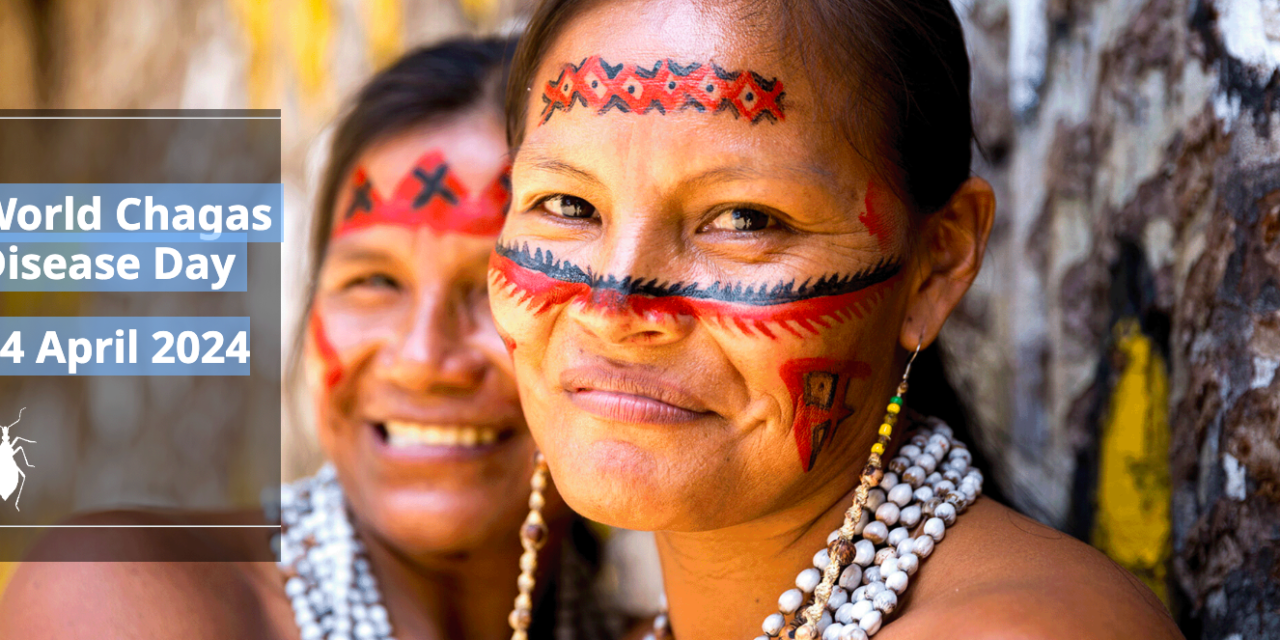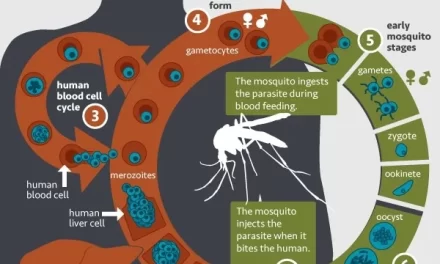Key facts
- About 6–7 million people worldwide, mostly in Latin America, are estimated to be infected with Trypanosoma cruzi, the parasite that causes Chagas disease.
- It can be transmitted by the triatomine bug (vector-borne), as well as orally (food-borne), during pregnancy or birth (congenital), through blood/blood products, organ transplantation and laboratory accidents.
- Chagas disease is curable if antiparasitic treatment is initiated early, in the acute phase. In chronic infection, the treatment and follow up can potentially prevent or curb disease progression and prevent transmission, for instance, during pregnancy and birth.
- Up to a third of people with chronic infection develop cardiac alterations and 1 in 10 develop digestive, neurological or mixed alterations which may require specific treatment.
- Key strategies to prevent Chagas disease include vector control (in Latin America); blood screening prior transfusion and transplantation; testing and treating girls, women of reproductive age, newborns and siblings of mothers with infection; and information, education and communication for communities and health professionals.
Chagas disease, also known as American trypanosomiasis, is a potentially life-threatening illness caused by the protozoan parasite Trypanosoma cruzi (T. cruzi).
In 2024 we are shining a spotlight on Chagas disease, the suffering it causes and are calling for equitable access to health care and services for everyone affected by the disease.
The theme for 2024 is Tackling Chagas disease: detect early and care for life, to increase public awareness of Chagas disease and secure greater funding and support for early diagnosis and life-long, comprehensive follow-up care initiatives.
Chagas disease is prevalent among poor populations of continental Latin America but is increasingly being detected in other countries and continents.
It is often termed as a “silent and silenced disease” as the infected majority have no symptoms or extremely mild symptom. There are approximately 6-7 million people infected with Chagas disease worldwide, with 12,000 deaths, every year.
Chagas disease is named after Carlos Ribeiro Justiniano Chagas, a Brazilian physician and researcher who discovered the disease in 1909. In May 2019, following up on decision of the 72 World Health Assembly, the World Chagas Disease Day was established to be celebrated on 14 April (the date of the year 1909 when Carlos Chagas diagnosed the first human case of the disease, a two-year old girl called Berenice).
Distribution
Chagas disease was once entirely confined to continental rural areas of the Americas. Due to increased population mobility, most infected people now live in urban settings and the infection has been detected in 44 countries (including Canada, the United States of America, and many European and some Western Pacific, African and Eastern Mediterranean countries).
Transmission
In Latin America, T. cruzi parasites are mainly transmitted by contact with faeces/urine of infected blood-sucking triatomine bugs. These bugs typically live in the wall or roof cracks of homes and surrounding structures, such as chicken coops, pens and warehouses, in rural or suburban areas. Normally they hide during the day and become active at night when they feed on animal and human blood. They usually bite an exposed area of skin such as the face, and defecate or urinate close to the bite. The parasites enter the body when the person instinctively smears the bug’s faeces or urine into the bite, other skin breaks, the eyes or the mouth. T. cruzi can also infect animals; common opossums are considered one of the most important wild reservoirs of infection.
T. cruzi can also be transmitted:
- by consumption of food or beverages contaminated with T. cruzi through, for example, contact with faeces or urine of infected triatomine bugs or common opossums; this kind of transmission typically causes outbreaks;
- during pregnancy or childbirth;
- through blood or blood product transfusion;
- through transplants of some organs (such as heart or kidney); and
- through laboratory accidents.
Signs and symptoms
Chagas disease presents in two phases. The initial acute phase lasts for about two months after infection. Although a high number of parasites can circulate in the blood, in most cases symptoms are absent or mild and non-specific (fever, headache, enlarged lymph glands, pallor, muscle pain, difficulty in breathing, swelling, and abdominal or chest pain). Much less frequently people bitten by a triatomine bug show the characteristic first visible signs, which can be a skin lesion or a purplish swelling of the lids of one eye.
During the chronic phase, the parasites are hidden mainly in the heart and digestive muscles. One to three decades after infection, up to a third of patients suffer from cardiac disorders and up to 1 in 10 suffer from digestive (typically enlargement of the oesophagus or colon), neurological or mixed alterations. In later years these patients may experience the destruction of the nervous system and heart muscle, consequent cardiac arrhythmias or progressive heart failure, and sudden death.
Diagnosis
During the acute phase or during reactivation because of immunosuppression (which can be caused by old age, radiation, chemotherapy or AIDS), diagnosis is made by direct detection of the parasite circulating in the bloodstream. To this end a blood wet smear or a blood concentration technique such as microhaematocrit or Strout technique, must be used.
Stained preparations, such as malaria films, detect the parasites when parasitaemia is high (acute phase). In the Amazon Basin, microscopy technicians who diagnose malaria have been trained to detect acute individual cases of Chagas disease and, through them, identify possible foodborne outbreaks.
During the chronic phase, when the parasite is hidden in target tissues, diagnosis is made via the detection of antibodies against T. cruzi (serological techniques) using serological tests. Some of the most frequently used techniques are: enzyme-linked immunosorbent assay (ELISA), indirect haemagglutination assay, indirect immunofluorescence assay, western blot and rapid diagnostic tests such as immunochromatography.
For strict research purposes, molecular tests (qualitative and quantitative polymerase chain reaction) and parasitological tests (haemoculture and xenodiagnosis – with examination of the faeces of uninfected triatomine bugs that have fed from an infected patient’s blood) may also be used.
Treatment
Chagas disease can be treated with benznidazole or nifurtimox. Both medicines kill the parasite and are fully effective in curing the disease if given early in the acute phase, including in case of congenital transmission. Their efficacy diminishes, however, the longer a person has been infected; also, adverse reactions are more frequent in older age. Treatment is also indicated for patients in whom infection has been reactivated (for example, due to immunosuppression), and during the early chronic phase, including for girls and women of childbearing age (before or after pregnancy) to prevent congenital transmission.
Adults with infection, especially those with no symptoms, should be offered treatment because antiparasitic medicines can also prevent or curb disease progression. In other cases, the potential benefits in preventing or delaying the development of Chagas disease should be weighed against the duration of treatment (up to 2 months) and possible adverse reactions (occurring in up to 40% of adults). Benznidazole and nifurtimox should not be administered to pregnant women or people with kidney or liver failure. Nifurtimox is also contraindicated for people with a background of neurological or psychiatric disorders. Additionally, specific life-lasting treatment and follow up for cardiac, digestive or neurological manifestations is required.
Control and prevention
The large reservoir of T. cruzi parasites in wild animals throughout the Americas means that the infection cannot be eradicated. Instead, the public health targets are elimination of the transmission to humans, early health-care access and life-long follow up of the infected people.
There is no vaccine to prevent Chagas disease. T. cruzi can infect many species of triatomine bugs, the majority of which are found in the Americas. Vector control has been the most effective method of prevention in Latin America. Blood screening is necessary to prevent infection through transfusion, organ transplantation, and congenital transmission, and to increase detection and care of the affected population all over the world.
Depending on the geographical area, WHO recommends the following approaches to prevention and control:
- development of information, education and communication materials and activities, contextualized for the different scenarios and actors, and based on a One Health approach;
- spraying of dwellings and surrounding areas with residual insecticides;
- house improvements and house cleanliness to prevent vector infestation;
- personal preventive measures such as bednets, good hygiene practices in food preparation, transportation, storage and consumption;
- screening of blood donors;
- testing of organ, tissue or cell donors and receivers;
- early access to diagnosis, treatment and follow up; and
- screening of newborns and other children of infected mothers.
The medical care cost of patients with chronic cardiac, digestive, neurologic or mixed forms of the disease has been calculated to be >80% higher than the cost of spraying residual insecticide to control vectors and prevent infection.
Health professionals working at the first level of care (primary health care) have a key role in strengthening detection, treatment, follow up and notification of cases.
Assessment of the available diagnostics (including rapid serologic or chemiluminescence tests, molecular biology tests) and the most cost-effective algorithms is fundamental to increase early case detection.
Promotion of biomedical, psychosocial and environmental studies focused on the determinants and risk factors of Chagas disease is essential to identify novel approaches for prevention and control.
National information systems are essential to monitor the number of acute and chronic cases and the active transmission routes, but are in place only in 6 out of the 44 countries that have reported cases so far.
Key messages
Increase awareness about Chagas disease: Chagas disease, predominantly affecting impoverished populations in Latin America, is increasingly spreading across continents. With 6-7 million infections globally and significant mortality rates, it poses a substantial public health threat. An estimated 12,000 people die from Chagas disease every year, and about 75 million people are at risk of acquiring the disease.
Unite and act against Chagas disease: From policymakers to partners, donors and academia, concerted efforts are needed to strengthen access to early diagnosis, safe treatment, lifelong care, as well as robust surveillance systems and screening, starting at the primary care level. More investments on research & development for medicines and diagnostics are imperative for combating Chagas disease effectively.
Support people with Chagas disease: Often referred to as a “silent disease” as the infected majority have no symptoms (or mild symptoms), Chagas disease mostly affects marginalized and impoverished communities. Promoting initiatives to overcome barriers to healthcare access for marginalized populations affected by the disease, as well as advocating for comprehensive care and support systems will improve outcomes for all affected individuals and their families.
Address stigma and discrimination: Stigmatization isolates sufferers, hindering timely diagnosis and treatment. It’s time to end any kind of stigmatization, discrimination or negligence against people with Chagas disease.
Call for action
General public, health professionals, communities, patient groups…
- Share accurate, evidence-based and updated information about risks associated with Chagas disease.
- Talk about Chagas diseases, without pointing to locations or ethnicity of people affected by the disease.
- Be empathetic towards people infected with Chagas disease.
Policy makers
- Increase investments in capacity and resources towards prevention, diagnosis, control, surveillance and screening, starting at primary healthcare level.
- Be aware that risk of infection is not limited to areas where bugs are found – transmission can also occur by transfusion of blood and blood products, organ transplantation, congenital routes, oral/foodborne routes and laboratory accident.
- Include Chagas disease among policies related to migrants’ health.
Partners and donors
- Advocate for early detection, care, epidemiological surveillance, and increased investment, starting at primary healthcare level
- Increase investments and work with governments and local health authorities towards funding access to early diagnosis, safe treatment, care, surveillance and screening, starting at primary care level.
Academia and researchers
- More research is needed on effective diagnostics and medicines, and on cost-effective interventions for vector control, hygiene and food safety.












